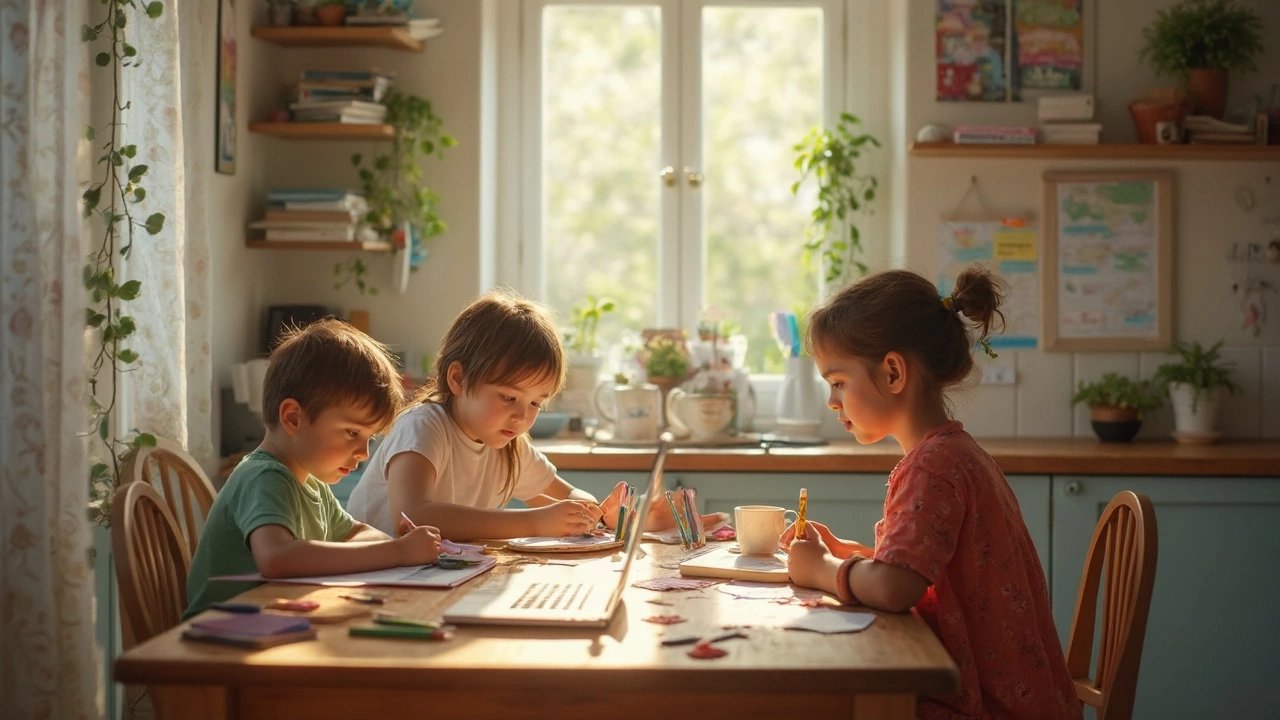Think homeschooling is all about kids lounging in pajamas and doing math on the couch? There’s a bit more to it than that. About 4 million kids in the US are homeschooled now, and that number keeps climbing. But homeschooling works differently for every family and kid.
Parents usually jump in for control: control over what their kids learn, how fast they move, and the kind of environment they grow up in. Some just want to dodge rigid school schedules or avoid the drama that comes with certain classroom settings. But it’s not a magic fix—all the usual school headaches don’t just vanish when you ditch the yellow bus.
If you’re stuck on whether it’s worth it, start with your real reasons. Are you looking for flexibility because your kid’s got a unique talent? Want to avoid bullying? Or maybe you need a huge shake-up after the pandemic made you rethink everything about education. Being clear about what you want is the first step. It’ll help you figure out whether homeschooling could be your family’s win-win or just a fast track to frustration.
- Why People Choose Homeschooling
- What Homeschooling Looks Like (For Real)
- The Big Benefits Nobody Talks About
- Hidden Pitfalls and Honest Drawbacks
- Tips for Making Homeschooling Smoother
- Is It the Right Fit For You?
Why People Choose Homeschooling
Most parents who pick homeschooling aren’t just making a snap decision. There’s usually a good reason behind it. Some parents feel like public or private schools don’t work for their kids—either because of teaching style, pace, safety, or the kind of social environment. Others are driven by special needs, chronic illnesses, or even careers that require moving around a lot (military families, for example).
The pandemic turned things upside-down, so a lot of families got a trial run with learning at home. After that, many just didn’t send their kids back, either because it worked out way better than expected or because schools didn’t adapt well to remote learning. Even religious reasons count—some families want education that lines up with their beliefs, and homeschooling lets them do that.
- Worried about bullying or peer pressure? Homeschooling can offer a safe space.
- Does your kid learn way faster or slower than the average classroom? At home, you set the pace.
- Kids with ADHD, dyslexia, or other special needs often get more personalized attention with homeschooling.
- Want more time for sports, the arts, or travel? Homeschooling usually means a flexible calendar.
Let’s look at what parents say when asked why they homeschool. This breakdown is from a real survey (National Center for Education Statistics, 2023):
| Main Reason | Percent of Parents |
|---|---|
| Concern about school environment (safety, drugs, peer pressure) | 80% |
| Wanting to provide religious or moral instruction | 60% |
| Dissatisfaction with academic instruction at school | 50% |
| Special needs (physical or mental health) | 39% |
| Other reasons (family, flexibility, etc.) | 20% |
As you can see, it’s not just one thing. Homeschooling gives families the chance to build an education that matches what matters most to them. If you ever hear someone say it’s just for quirky or extreme people, that’s just not true anymore. It’s a real option that’s going mainstream, with very practical reasons behind it.
What Homeschooling Looks Like (For Real)
If you imagine homeschooling as non-stop crafts and science experiments, think again. The reality is sometimes messy, often flexible, and always unique to each family. There’s no one-size-fits-all day, but there are some patterns that show up for most homeschoolers.
About 70% of homeschooling families follow some kind of structure or curriculum, but the rest take a more relaxed—some call it "unschooling"—approach. You can grab a ready-made curriculum online, piece subjects together yourself, or even use public school resources if your district offers them. Either way, parents become the main coach—teaching, planning, and sometimes learning right alongside their kids.
Here’s what a real day might include:
- Shorter lessons: Most homeschooled kids finish their core subjects by lunch. Instead of switching classrooms, transitions are quick. No long waits for 30 kids to line up or get quiet.
- Learning everywhere: The kitchen, the backyard, the library—sometimes even the car. Homeschooling breaks up the monotony, since you aren’t chained to a desk.
- Mixed ages: Siblings often learn together, with older kids helping the younger ones out. It’s not odd for a 9-year-old and a 12-year-old to work on science as a team.
- Built-in field trips: Museums, parks, nature centers—these become regular classrooms, not rare out-of-school treats.
Meal prep and chores often get folded in as life skills, not just "extras." Some days run smooth, others feel like a mess. Kids may work ahead in subjects they love or slow down when something trips them up. Parents need to keep records, check state laws, and sometimes report progress to school districts. Each state in the US handles homeschooling rules differently, so it’s worth double-checking what your local requirements are.
To give you a quick sense of how homeschooling families split their time compared to public schoolers, check out this rough breakdown:
| Activity | Homeschooling | Traditional School |
|---|---|---|
| Core subjects (math, reading, etc.) | 2–3 hours/day | 4–5 hours/day (with transitions) |
| Recess/PE/free time | Flexible, often outdoors | Scheduled, limited recess |
| Chores/life skills | Daily, woven in | Mostly after school |
| Field trips/outside activities | 1–2/month, sometimes more | Few per year |
One thing that surprises new parents? Homeschooling isn’t just about academics. The flexibility lets families pursue weird interests, from coding video games in middle school to baking bread for math practice. The biggest win for most: the chance to shape learning around your kid, not the other way around. Homeschooling can look like whatever works for you—not what you see on Instagram.
The Big Benefits Nobody Talks About
It’s easy to get caught up in test scores and socialization debates, but there are some legit perks to homeschooling that rarely make headlines. One thing you probably won’t hear in school hallways: homeschooled kids often get more sleep. Most public schools start ridiculously early, but with homeschooling, you set your own schedule, so teens especially aren’t walking around like zombies. This matters—a study from the American Academy of Sleep Medicine found teenagers who start later actually perform better and feel healthier.
Another bonus? Real-life learning. Ever try to teach fractions using an actual pizza at noon on a Tuesday? Not only does it make math click, but it also makes lessons practical. You can work trips to the grocery store, the bank, or local museums into your week as hands-on educational time. Textbooks are nice, but nothing beats figuring out change at the counter or reading a map on a family hike.
Let’s not skip the relationship part. Homeschooling can mean way more time for real conversations. You notice what fires up your kid, you see what frustrates them, and you can shift things right away. Some families say the daily stress dips big time without constant homework battles and rushing out the door by 7 a.m. This gives space for everyone to focus on mental health, not just cramming for state tests.
Plus, there’s more freedom to target learning toward each kid. If your child loves coding or painting, you can lean into those interests—sometimes hours every day—not just what’s next on a generic curriculum list. This personalized pace is why some homeschooled students jump ahead in subjects they love and take more time on stuff that trips them up, all without embarrassment.
Finally, when lessons finish faster, kids get more time back for the rest of life: picking up a part-time job, volunteering, or launching that Etsy craft store. It’s not all about hitting “book work” for six straight hours; it’s about making education fit your real world.

Hidden Pitfalls and Honest Drawbacks
Homeschooling sounds great on the surface, but it’s not all sunshine and easy mornings. First up, teaching isn’t just about knowing stuff—it’s about explaining it a hundred times in five different ways and not losing your cool. That can get exhausting fast, especially if you’re balancing a job or other kids. Not every parent feels confident as a teacher, and that stress is real.
Let’s talk about social life. Everyone’s heard the classic question: “But what about friends?” In a traditional school, kids see dozens of peers every day. At home, it’s easy for a child to feel isolated if you don’t make an effort to set up co-ops, meet-ups, or activities outside the house. Lonely kids don’t thrive, academically or emotionally.
Resources matter, too. While the internet’s full of cool lesson plans and videos, many parents hit a wall with higher-level subjects. It’s common for families to pay for tutors or outside classes, especially once high school rolls around. That can add up fast. And remember, if your state has strict homeschooling laws, you might need to keep detailed records, show portfolios, or prep your kid for standardized tests—which can be a headache.
Here’s a quick breakdown of some of the real challenges, compared to traditional schooling:
| Hidden Drawback | Homeschooling | Traditional School |
|---|---|---|
| Teacher Burnout | Can be high for parents, especially solo homeschoolers | Spread across staff, professionals handle teaching |
| Daily Social Interaction | Needs effort to organize | Built-in with classmates |
| Subject Challenges | Parents may need external help for advanced topics | Specialized teachers available |
| Regulations | Varies by state, sometimes strict | Handled by school administration |
| Cost | Varies, can increase with curriculum/tutors | Usually just supplies & fees |
It’s also easy to underestimate the planning—homeschooling can be a full-time job in itself. Juggling lesson plans, learning needs, and daily routines takes serious work. Sometimes, expectations don’t match reality. Families might start out expecting amazing results, but get stuck dealing with stubborn kids and endless distractions.
- If you’re aiming for top-notch homeschooling, you’ll need solid time management and a thick skin for setbacks.
- Stay realistic about your ability to teach different ages and subjects.
- Think ahead about building a social network—and don’t be afraid to ask for help when things get overwhelming.
Tips for Making Homeschooling Smoother
Homeschooling can turn chaotic fast if you don’t set up a few ground rules. I’ve seen way too many families burn out because they tried to wing it. You don’t have to run your house like a mini public school, but having a plan is a lifesaver.
- homeschooling doesn’t mean you need to recreate an eight-hour school day. Most kids actually need just two to four focused hours a day to cover their core subjects. Keep it tight and move on when the learning’s done—then you have the rest of the day for interests or downtime.
- Use free and low-cost resources. Sites like Khan Academy, Crash Course, and Duolingo cover pretty much every subject. A lot of public libraries run free classes or study groups for homeschoolers—take advantage of these.
- Don’t go it alone. Nearly every area in the US now has local homeschooling co-ops. These are real lifesavers for parents who need a break or want their kids to get group learning, field trips, or sports.
- Track progress in a way that works for you. Some parents use plain notebooks or digital apps (like Homeschool Panda or Seesaw) to log lessons, which helps if your state ever asks for records.
- Rotate who teaches if you can. Got a partner or grandparent willing to lead science or art? Use them. No one says you have to do this solo.
- Every kid learns differently, so change your approach if something’s not clicking. If your kid is struggling with textbooks, try YouTube videos or hands-on experiments from household stuff (baking actually teaches a ton of math and science—no joke).
You’ll hit rough patches. That’s normal. The key is not to let small failures blow up your confidence. If something’s not working, tweak it instead of scrapping the whole routine. Honestly, flexibility is the best thing you can build into your day.
Is It the Right Fit For You?
Homeschooling isn’t just for families who travel the world or live off the grid. It’s showing up in all kinds of neighborhoods—big city, rural, suburbs. But before you jump in, it pays to be brutally honest with yourself about what you can actually handle at home.
Here’s the straight-up checklist you should run through:
- Time Commitment: Homeschooling is a serious time investment. Most parents spend about 3–5 hours a day actively teaching, planning, or helping with lessons. If you work full-time outside the house with no flexible schedule, it’s going to be tough—unless you have extra help or older kids who can self-direct.
- Teaching Patience: You don’t need a teaching degree, but you do need patience for the million questions and the days when fractions just don’t make sense. If schoolwork always led to fights before, homeschooling can magnify that unless you approach it differently.
- Financial Impact: One parent often shifts to part-time work or steps away from a job to make it work. There are costs—curriculum, supplies, potential field trips. It usually isn’t free, but you can control the spending way more than with private schools.
- Social Side: The old stereotype about homeschooled kids being isolated isn’t true anymore—unless you choose to stay home all the time. Tons of local co-ops, online classes, sports leagues, and library events keep kids connected. You do have to make an effort to get out there.
- Legal Requirements: Every state makes its own rules. Some are super relaxed (think Texas, Alaska); others want yearly reports, attendance tracking, or testing (like New York, Massachusetts). Make sure you know what’s actually required where you live. Good news: Getting connected with a local homeschool group takes the guesswork out of the paperwork.
Homeschooling can be awesome for kids who need extra academic support, those who want more challenging work than their grade, or kids who just can’t focus in a busy classroom. Not every family is built for it, though. If having structure and clear boundaries is impossible in your house, or you’re always arguing about homework, adding more school tasks at home probably won’t solve it.
Before making the leap, try this mini-test:
- Shadow your kid during a typical school break and see if you can manage structured learning at home, even if just for a week.
- Talk to real families in your area who are into homeschooling—not just in Facebook groups. Ask them what surprised them and what they’d do differently.
- List your priorities: Is it about academics, protecting mental health, or just ditching busywork? Homeschooling isn’t one-size-fits-all, so your reason determines your method.
Choosing homeschooling means taking on more control—and more responsibility. Some days will feel like a breeze; other days, you’ll want to throw the math book right out the window. If you’re up for the challenge and your family agrees, it could be the best move you ever make.






